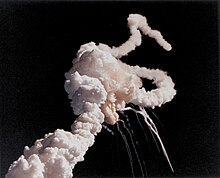Space Shuttle Challenger

Space Shuttle Challenger (OV-099) was the second space shuttle used by NASA to fly into outer space. The shuttle broke up 73 seconds after take-off from Cape Canaveral on 28 January 1986.[1] All seven astronauts who were on it at the time were killed. The crash happened because a rubber tube called an o-ring did not expand to fill a gap in one of the booster rockets, due to cold weather.
The Challenger was named after a Royal Navy ship that explored the Pacific and Atlantic Oceans from 1872 to 1876. Challenger was also the name of the Apollo 17 Lunar Excursion Module.
Crew[change | change source]

- Francis "Dick" Scobee (46)
- Michael John Smith (40)
- Judith Resnik (36)
- Ellison Onizuka (39)
- Ronald McNair (35)
- Gregory Jarvis (41)
- Christa McAuliffe (37), first teacher in space
Missions[change | change source]
| # | Date | Designation | Launch pad | Landing location | Notes |
|---|---|---|---|---|---|
| 1 | 04.April.1983 | STS-6 | 39-A | Edwards Air Force Base | First Shuttle Space Walk |
| 2 | .18.June.1983 | STS-7 | 39-A | Edwards Air Force Base | First U.S. Woman in Space |
| 3 | 30. August.1983 | STS-8 | 39-A | Edwards Air Force Base | First Night Launch and Landing |
| 4 | 03. February.1984 | STS-41-B | 39-A | Kennedy Space Center | First KSC Landing |
| 5 | 06.April.1984 | STS-41-C | 39-A | Edwards Air Force Base | First on-orbit spacecraft repair. |
| 6 | 05.October.84 | STS-41-G | 39-A | Kennedy Space Center | Earth Radiation Budget Satellite, Office of Space and Terrestrial Applications-3. |
| 7 | 29.April.1985 | STS-51-B | 39-A | Edwards Air Force Base | Spacelab-3 |
| 8 | 29. July.1985 | STS-51-F | 39-A | Edwards Air Force Base | Spacelab-2 |
| 9 | 30.October.1985 | STS-61-A | 39-A | Edwards Air Force Base | D-1 Spacelab Mission (First German Dedicated Spacelab) |
| 10 | 28 January 1986 | STS-51-L | 39-B | Did not land(Planned to land at Kennedy Space Center) | TDRS-2; SPARTAN-203 Satellites. Shuttle destroyed after liftoff & all seven astronauts on board died. |
References[change | change source]
- ↑ "Space Today Online - Space Shuttle Stories". spacetoday.org. Retrieved 19 November 2010.



